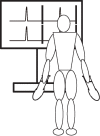Effect of bilateral contraction on the ability and accuracy of rapid force production at submaximal force level
- PMID: 33600476
- PMCID: PMC7891739
- DOI: 10.1371/journal.pone.0247099
Effect of bilateral contraction on the ability and accuracy of rapid force production at submaximal force level
Abstract
The present study aims to clarify the effects of bilateral contraction on the ability and accuracy of rapid force production at the submaximal force level. Eleven right-handed participants performed rapid gripping as fast and precisely as they could in unilateral (UL) and bilateral (BL) contractions in a standing position. Participants were required to impinge a grip force of 30% and 50% of their maximal voluntary contraction (MVC). Ability and accuracy of rapid force production were evaluated using the rate of force development (RFD) and force error, respectively. The data analysis did not observe a significant difference in the RFD between UL and BL contractions in both 30% (420±86 vs. 413±106%MVC/s, p = 0.34) and 50% of MVC (622±84 vs. 619±103%MVC/s, p = 0.77). Although the RFD to peak force ratio (RFD/PF) in BL contraction was lower than in UL in 30% of MVC (12.8±2.8 vs. 13.4±2.7, p = 0.003), it indicated a small effect size (d = 0.22) of the difference between UL and BL in RFD/PF. The absolute force error of BL contraction was higher than of UL contraction in 30% (4.67±2.64 vs. 3.64±1.13%MVC, p = 0.005) and 50% of MVC (5.53±2.94 vs. 3.53±0.71%MVC, p = 0.009). In addition, medium and large effect sizes were observed in absolute force error from 30% (d = 0.51) and 50% of MVC (d = 0.94), respectively. In conclusion, results indicated that the bilateral contraction reduced in the ability and accuracy of rapid force production at the submaximal force level. Nevertheless, the present results suggest that the noticeable effect of bilateral contraction is more prominent on the accuracy than in the ability of rapid force production at the submaximal force level.
Conflict of interest statement
The authors have declared that no competing interests exist.
Figures





References
-
- Knudson DV, White SC. Forces on the hand in the tennis forehand drive: application of force sensing resistors. Journal of Applied Biomechanics. 1989;5(3):324–31.
-
- La Monica MB, Fukuda DH, Muddle TWD, Beyer KS, Wang R, Hoffman JR, et al. Force-time characteristics during an explosive isometric gripping task: effects of a 10-week introductory judo course. Journal of Combat Sports and Martial Arts. 2017;2(8):101–5.
-
- Stretch R, Buys F, Viljoen G. The kinetics of the drive off the front foot in cricket batting: hand grip force. South African Journal for Research in Sport, Physical Education and Recreation. 1995;18(2):83–93.
-
- Li F-X, Turrell Y. 18 Control of grip force in interceptive sport actions. Interceptive actions in sport: Information and movement. 2002:301.
Publication types
MeSH terms
LinkOut - more resources
Full Text Sources
Other Literature Sources

